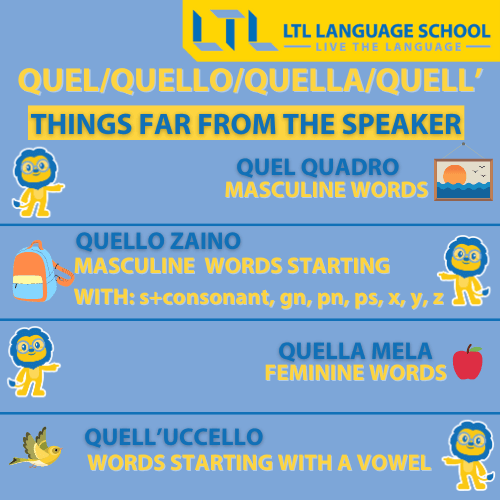
Italian Grammar Bank
ITALIAN DEMONSTRATIVE ADJECTIVES (THIS, THAT…)

Today we’ll talk about some Italian words that we use every day: demonstratives!
Demonstratives can identify objects or people, points in the surrounding space, and moments in time. To interpret them, in particular, it is necessary to refer to where the speaker is in terms of time and place, as they identify objects or people based on their proximity or distance from the speaker.
They can work both as adjectives (in this case they’re placed in front of a noun) and pronouns (in this case they substitute the noun).
THIS: QUESTO, QUESTA, QUEST’
Questo, questa, and quest’ all mean “this“, and are demonstrative adjectives used before singular words. We use them when we are talking about something near us in space or time.
PATTERN
QUESTO/QUESTA/QUEST’ + SINGULAR WORDS
Cosa fai questo weekend?
What are you doing this weekend?Ti piace questo maglione?
Do you like this sweater?Questa sedia è scomoda.
This chair is uncomfortable.
They can also be used when we are telling a story; it’s like we are inside the story, so it feels like the noun we are referring to is near:
Allora sono salito sul treno e vicino a me si è seduto questo tipo strano…
So I got on the train and this strange guy sat next to me…How do you choose between questo, questa, and quest’? That’s quite simple:
| questo | questa | quest’ | |
|---|---|---|---|
| USED WITH | Singular masculine words | Singular feminine words | Singular words starting with a vowel |
| EXAMPLES | Questo ragazzo, questo zaino | Questa rosa, questa sedia | Quest'anno, quest'estate * |
THAT: QUELLO, QUELLA, QUEL, QUELL’
Quello, quel, quella and quell’ all mean “that“, and are demonstrative adjectives used before singular words.
PATTERN
QUELLO/QUELLA/QUEL/QUELL’ + SINGULAR WORDS
We use them when we are talking about something far from us in space or time:
| ITALIAN | ENGLISH |
|---|---|
| Cos’hai fatto quel weekend? | What did you do on that weekend? |
| Ti piace quel maglione? | Do you like that sweater? |
| Quella sedia è scomoda. | That chair is uncomfortable. |

How do you choose between quello, quel, quella, and quell’? That’s quite simple:
| quel | QUELLO | quella | quell’ | |
|---|---|---|---|---|
| USED WITH | Singular masculine words | Singular masculine words starting with: s+consonant, gn, pn, ps, x, y, z | Singular feminine words | Singular words starting with a vowel |
| EXAMPLES | Quel giorno, quel ragazzo | Quello studio, quello zaino | Quella penna, quella storia | Quell'amico, quell'ora |
THESE: QUESTI, QUESTE
The Italian demonstratives meaning “these” are very simple: we use questi with any plural masculine word referring to things close to the speaker in terms of time and place and queste with feminine ones.
PATTERN
QUESTI/QUESTE + PLURAL WORDS
| ITALIAN | ENGLISH |
|---|---|
| In questi giorni mi sono riposato un po’. | These days I got some rest. |
| Questi vestiti sono caldi. | These clothes are warm. |
| Queste riunioni non finiscono mai. | These meetings are never-ending. |

How do you choose between questi and queste?
| questi | QUEste | |
|---|---|---|
| USED WITH | Plural masculine words | Plural feminine words |
| EXAMPLES | Questi ragazzi, questi orologi | Quelle vecchiette, quelle scarpe |
THOSE: QUEGLI, QUEI, QUELLE
The Italian demonstratives meaning “those” are three:
- Quei
- Quegli
- Quelle
We use them to talk about things far from the speaker in terms of time and place.

How do you choose between them? We use:
| quei | QUEgli | quelle | |
|---|---|---|---|
| USED WITH | Plural masculine words | Plural masculine words starting with: a vowel, s+consonant, gn, pn, ps, x, y, z | Plural feminine words |
| EXAMPLES | Quei giorni, quei ragazzi | Quegli amici, quegli zaini | Quelle penne, quelle storie |
View more phrases
| italian | english |
|---|---|
| Guarda quelle nuvole! | Look at those clouds! |
| Quanto costano quegli stivali? | How much are those boots? |
| Cosa fanno quei bambini? | What are those kids doing? |
In all the cases seen above, demonstratives are used as adjectives, and thus are always referred to and followed by a noun (although there may be other adjectives in between, e.g., “questo piccolo grande amore”).
Demonstratives, however, can also be used as pronouns. Find out more in the next section.
DEMONSTRATIVE PRONOUNS
A demonstrative pronoun is a word used to stand in for a noun. They are used to point to something or someone specific, which is normally mentioned before or understandable by the context.
The Italian demonstrative pronouns are:
| italian demonstrative pronouns |
|---|
| Questo |
| Questa |
| Quello |
| Quella |
| Questi |
| Queste |
| Quelli |
| Quelle |
They substitute a noun, so they’re not followed by one.
Questo è mio, quello è tuo.
This one is mine, that one is yours.Queste sono meglio di quelle.
These are better than those.Cosa sono quelli?
What are those?| questo | QUEsta | queste | questi | |
|---|---|---|---|---|
| THEY SUBSTITUTE | Singular masculine words referring to something near | Singular feminine words referring to something near | Plural feminine words referring to something near | Plural masculine words referring to something near |
| quello | QUElla | quelle | quelli | |
|---|---|---|---|---|
| THEY SUBSTITUTE | Singular masculine words referring to something far | Singular feminine words referring to something far | Plural feminine words referring to something far | Plural masculine words referring to something far |
Pay attention, in particular, to “quelli“: this word is only used as a pronoun, not as an adjective. Vice versa, “quei” and “quegli” are adjectives, therefore should never be used by themselves, they always need a noun.
Sometimes, quello, quella, quelli, and quelle are followed by an adjective or specification to distinguish the object they substitute from another one.
👇🏼 Look at the example and the translation, and it will all be clear:
| Quello biondo è Giovanni, quello moro è Luca. | The blond one is John, the dark one is Luke. |
| Ti piacciono di più quelle di pelle o quelle di tela? | Do you like the leather ones or the fabric ones better? |
| Quella rossa è mia, quella blu è di Sofia. | The red one is mine, the blue one is Sofia’s. |
In the spoken language, to add emphasis, questo, questa, questi, and queste are often followed by “qui” or “qua“, meaning “here”; while quello, quella, quelle, and quelli are often followed by “lì” or “là“, meaning “there”.
PATTERN
QUESTO/A/I + QUI/QUA
PATTERN
QUELLO/A/E + LÌ/LÀ
Questi qui sono nuovi.
These ones here are new.Quello là è mio fratello.
That one there is my brother.The best way to learn demonstratives is using them, hearing them, and reading them.
They are everywhere: keep on practicing and they will have no more secrets!

Learn Italian with FlexiClasses
Book online classes with the best teachers in the industry.
FAQs
What are Italian demonstratives and how are they used?
Demonstratives in Italian are words that identify objects, people, points in space, and moments in time. They can function as adjectives or pronouns, indicating proximity or distance from the speaker.
How do you choose between “questo,” “questa,” and “quest'”?
The choice depends on the gender and starting letter of the word. “Questo” is for masculine, “questa” for feminine, and “quest'” for masculine and feminine words starting with a vowel.
What does “‘sto” mean?
‘Sto, ‘sti, ‘sta, ‘ste are slang forms of the adjectives questo, questi, questa and queste: they’re only used in very informal settings: on the internet, the apostrophe is usually omitted.
How do Italian demonstratives work as adjectives?
Italian demonstratives work as adjectives when placed before a noun. They vary based on the gender and number of the words they refer to, similar to articles.
What are Italian demonstrative pronouns and how are they used?
Demonstrative pronouns in Italian, such as “questo,” “questa,” “quello,” etc., replace nouns and stand alone. They are used to point to something specific mentioned earlier or understood from context.
What does “questo qui” mean?
In spoken Italian, demonstratives like “questo” and “questa” may be followed by “qui” or “qua” (meaning “here”) for emphasis, while “quello” and “quella” may be followed by “lì” or “là” (meaning “there”).








